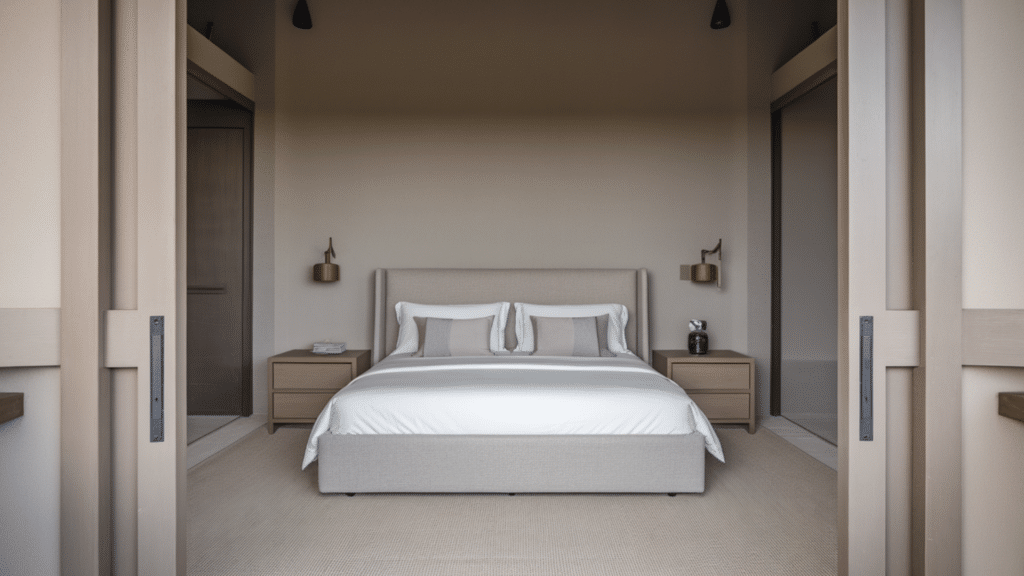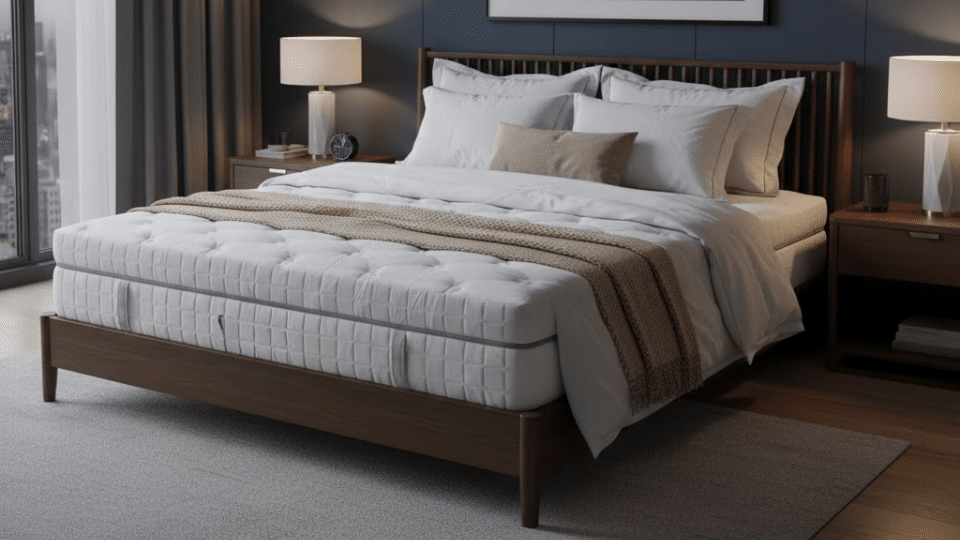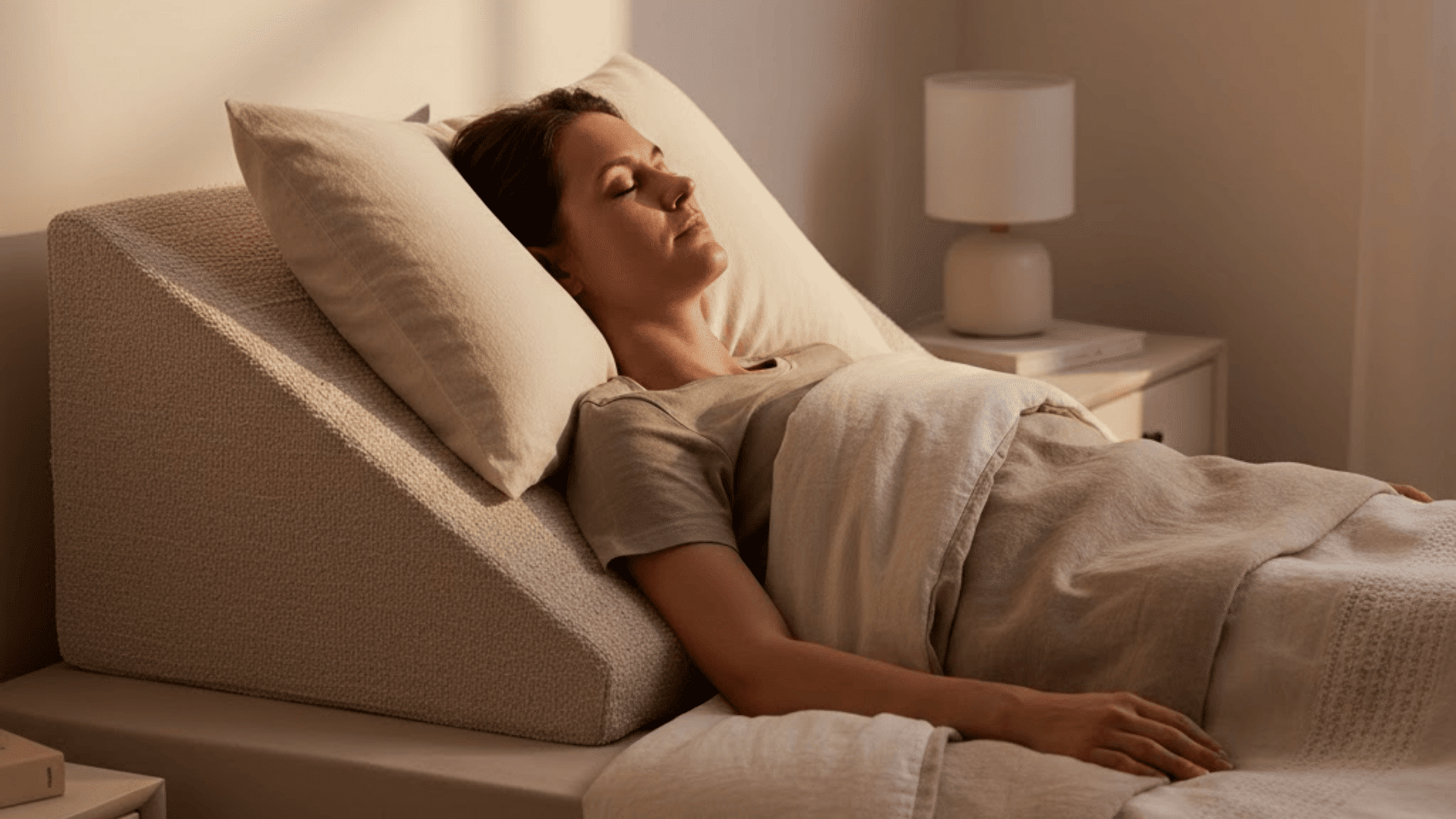Ever wake up with a sore shoulder and wonder what went wrong overnight? I’ve had those mornings too, and if you sleep on your side, your position might be part of the problem.
Shoulder pain while sleeping on your side is more common than you’d think, and it can seriously mess with your rest.
Today, I’m breaking down why side sleeping can lead to shoulder pain, how to adjust your posture, and which pillows or mattresses can actually help.
You’ll also find simple tips for easing the pain and know when it’s time to check in with a doctor. Let’s figure out what your shoulder’s trying to tell you.
Why Sleeping Position Matters for Shoulder Pain
The way you sleep can put a lot of stress on your shoulders. Side sleeping, especially without the right support, places direct pressure on the joint, muscles, and nerves.
Over time, this can cause inflammation, pain, or even worsen existing shoulder problems. Sleeping positions that twist or trap your arm under your body can make things worse overnight.
A few simple changes, like switching positions or adjusting your pillow, can ease that pressure and help you wake up with less pain and better range of motion.
Shoulder Pain Sleeping on Side: What Causes It?
Sleeping on your side can place pressure on shoulder structures, leading to pain, stiffness, or even nerve-related symptoms.
Direct Joint Pressure
When you lie on your side, your shoulder joint takes most of the body’s weight. On firm surfaces or with unsupportive pillows, this direct pressure compresses the joint, muscles, and bursa (fluid-filled sac).
Over time, this can irritate soft tissues and lead to inflammation, soreness, and discomfort. If you stay in the same position too long, blood flow and joint movement decrease, making the pain worse overnight or when you wake up stiff and sore in the morning.
Nerve Compression and Tingling
Side sleeping can pinch or compress nerves in the shoulder or neck. If your arm is tucked under your head or body, nerves like the brachial plexus may become irritated.
This often leads to numbness, tingling, or weakness in the arm. You may feel a dull ache, right shoulder blade pain, or a “dead arm” sensation when you wake.
These nerve-related symptoms are signs that your position is putting strain on sensitive pathways, and adjusting your posture is key to preventing long-term issues.
Rotator Cuff Injuries
The rotator cuff is a group of tendons and muscles that help lift and rotate your shoulder. Sleeping on your side can press these tendons into the bone, especially if you already have a tear or impingement.
This leads to pain when you lie down and worsens if you sleep on the injured side. You might notice pain when reaching overhead or lifting your arm during the day. Without support or treatment, these small issues can develop into chronic shoulder pain.
How Bursitis, Arthritis, and Rotator Cuff Pain Compare
Shoulder pain can feel similar regardless of the cause, but each condition has its own distinct signs. Here’s a quick breakdown of the differences that will help you treat it right:
Condition | Pain Type | Key Signs |
Bursitis | Sharp, sudden pain | Caused by pressure or overuse |
Rotator Cuff | Dull ache, weak arm | Pain lifting or rotating the arm |
Arthritis | Deep stiffness, grinding | Worse in the morning or with movement |
Recognizing what’s behind your pain gives you a better path to relief, whether it’s rest, therapy, or a visit to your doctor.
Sleeping With Shoulder Pain: The Wrong vs. Right Way
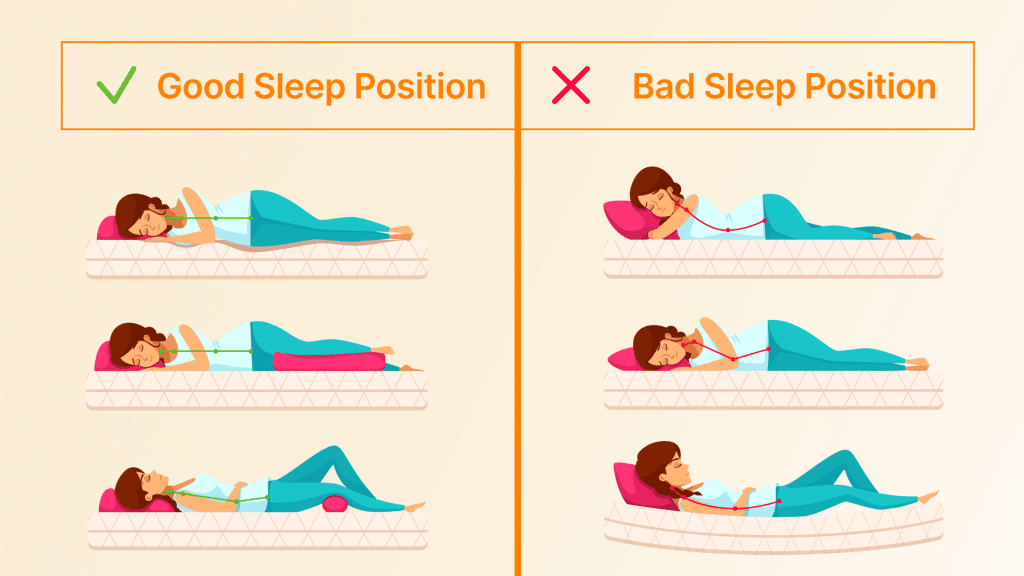
Your sleeping position can either increase shoulder stress or help relieve it; knowing the difference is key to feeling better.
Bad vs. Good Sleep Positions
Bad sleep posture often means your shoulder is trapped under your body or head, increasing joint pressure. A common mistake is tucking your arm under the pillow or sleeping with your elbow bent tightly.
In contrast, a better position supports the arm in front of the body using a pillow. This reduces compression on nerves and muscles.
Back Sleeping
Back sleeping is usually the most shoulder-friendly position because it keeps your spine and shoulders aligned naturally. It removes direct pressure from either shoulder and prevents arm compression.
To stay comfortable, place a small pillow under each arm or at your sides for light support. This can help reduce tossing and turning.
Back sleeping also improves circulation and reduces the chances of waking up with numbness, pain, or that “dead arm” feeling many side sleepers experience overnight.
Adjusted Side Sleeping
If you prefer sleeping on your side, you don’t have to give it up, but you do need better support. Use a firm body pillow in front of you and cradle your top arm across it. Make sure the bottom shoulder isn’t crushed beneath you.
Instead, let it rest forward slightly or extend outward. Placing a small pillow behind your back can keep you from rolling into a worse position. This setup reduces joint pressure and minimizes nighttime shoulder pain.
Best Pillows and Mattresses for Shoulder Pain Relief
The right pillow and mattress can ease shoulder pain by improving alignment, reducing joint pressure, and supporting healthy sleep posture.
Pillow Guide: Side vs. Back Sleepers
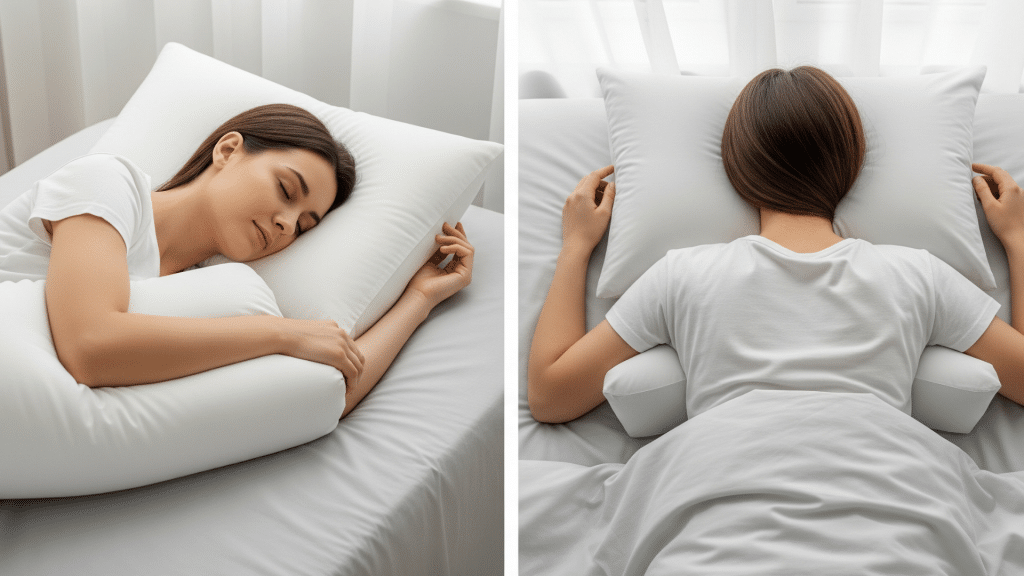
The type of pillow you use can make a significant difference, depending on your sleep style.
Side sleepers need a firmer, high-loft pillow that fills the space between their head and mattress. This keeps the neck aligned and reduces pressure on the shoulder. A body pillow or a small pillow in front of the chest can support the top arm.
Back sleepers need a thinner or medium-loft pillow with neck support to maintain alignment. Use a pillow under each arm for added comfort and stability, without compressing your shoulders.
Mattress Guide: What to Look For

A medium-firm mattress is typically best for alleviating shoulder pain, as it provides sufficient support without creating pressure points. It should allow your shoulder to sink slightly without collapsing your alignment.
Look for pressure-relieving materials like memory foam or latex that contour to your shoulder’s shape.
Hybrid mattresses can balance support and cushioning well. Avoid ultra-soft beds that lack structure or substantial ones that create too much pressure. The goal is to reduce shoulder strain while keeping your spine and hips in a natural, neutral position.
Other Home Remedies for Shoulder Pain at Night
Simple changes to your bedtime routine can ease inflammation and help you sleep more comfortably through the night.
Heat vs. Ice
Apply ice during the first 48 hours if your shoulder pain feels sharp or inflamed. Use a cold pack for 15–20 minutes, up to three times a day. For stiffness or lingering aches, switch to heat therapy.
A warm compress or heating pad used before bed can relax tight muscles and improve blood flow. Avoid falling asleep with heat or ice in place.
Over-the-Counter Pain Relief
Ibuprofen or acetaminophen can help reduce inflammation and relieve soreness before bed. Always follow the dosage instructions on the label.
Don’t mix medications unless your doctor approves. These options are best used in the short term while you focus on stretching, posture correction, and improved sleep support. If you rely on pain relievers often, talk to a doctor about long-term care.
Sleep Hygiene Tips
Building a calming nighttime routine supports healing and reduces sleep-related shoulder pain.
- Keep a regular bedtime, even on weekends
- Avoid screen time 30–60 minutes before bed
- Do gentle stretches before lying down
- Use soft lighting to wind down
- Keep your bedroom cool and quiet
- Avoid caffeine or heavy meals late in the day
What If the Pain is Under Your Right Shoulder Blade?
If your right shoulder blade pain doesn’t improve with simple changes, see your doctor to rule out deeper issues. It may feel like a dull ache, a stabbing sensation, or even tightness that spreads into your neck or upper back.
Common causes include muscle strain, poor posture, nerve irritation, or gallbladder issues. If this pain shows up after sleeping, poor position or lack of support may be the culprit.
Try adjusting your pillow, avoiding arm-overhead sleeping, and doing gentle stretches. If the pain spreads, worsens, or lasts more than a few days, it’s worth seeing a doctor to rule out other causes.
When to See a Doctor for Shoulder Pain
Not all shoulder pain from sleeping is mild or temporary. If your pain lasts for weeks, wakes you at night, or makes it hard to lift your arm, it’s time to see a doctor.
These signs could point to a serious issue like a rotator cuff tear, frozen shoulder, or arthritis. A medical provider may recommend physical therapy, cortisone injections, or imaging tests like an MRI or ultrasound.
In rare cases, surgery may be needed. Getting help early can prevent long-term damage and help you sleep better again.
Conclusion
Shoulder pain from sleeping on your side can take a real toll on how you feel throughout the day, but now you’ve got a better idea of what causes it and how to ease it.
I’ve learned that even small changes, like adjusting your position, switching pillows, or calming inflammation, can make a big difference.
Take a minute to think about your current sleep habits. Are they adding to your discomfort without you realizing it?
The tips I’ve given are here to help you sleep better and feel stronger. And if shoulder pain sleeping on the side is something you deal with often, now’s the perfect time to make a few smart tweaks.
Want more simple ways to improve your sleep and feel more comfortable? Check out my other blogs for practical, down-to-earth tips that really work.




